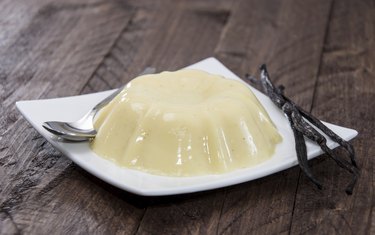
Any food that is high in protein can be processed for swallowing difficulties. Depending on the condition that is causing the swallowing difficulty, the food must be chopped, mashed, ground, pureed or liquified so that little to no chewing is necessary to get the food down your throat. If the food is not smooth enough, you may cough or choke, and possibly aspirate, thereby allowing the food to enter your lungs. Find out from your doctor or other health care provider how to accommodate your particular swallowing difficulties.
Swallowing Difficulties
Video of the Day
Difficulty swallowing is known as dysphagia and is the result of a muscle disorder that affects the movement of your mouth, jaw, throat or esophagus. Surgery or radiation to any part of the head and neck area can cause soreness or dryness in the mouth and throat and prevent muscles in the area from moving freely. Medical disorders such as stroke, head or neck cancer, Alzheimer's disease or Parkinson's disease can also cause swallowing difficulties severe enough to prevent normal eating.
Video of the Day
High-Protein Foods
Although your eating habits may change, your nutritional requirements do not, so you must find ways to get enough protein in your diet in spite of your swallowing difficulties. Since you may be eating less food overall as a result of your swallowing difficulties, it is important to include foods that are especially high in protein. High-protein foods that can be processed to accommodate swallowing difficulties include meat, poultry, fish, shellfish, eggs, dairy products such as milk, yogurt, cottage cheese and other soft cheese, and soy-based foods such as tofu and soy beverages. Cooked pasta and other soft-cooked grains also add protein to your diet. High-protein snacks and desserts include pudding, ice cream or sherbet.
Processing Methods
A food processor is the best tool for pureeing foods and does a better job at getting food smooth than a blender, according to the University of Florida Extension Service. Add liquids when pureeing meat, poultry, fish or other solid foods to make sure the result is smooth and easy to swallow without chewing. To make pureed high-protein foods taste more interesting, try the same creative flavor combinations you would enjoy in a regular meal, such as chicken and gravy, ham and pineapple juice, soft-cooked eggs with mayonnaise, high-protein pasta with tomato sauce or olive oil.
Tips
If you have swallowing difficulties, avoid rough, dry crackers, chips, granola and other dry cereals and hard foods such as nuts, hard cheese, raw vegetables and raw fruits such as apples. If you can chew before swallowing, with the permission of a health care provider, you may chop high-protein foods into tiny pieces rather than puree, but you must eat slowly and carefully. It may be easiest to eat your food at room temperature. It may be necessary to thicken some liquids or stick to smoothies and shakes to get the right consistency.